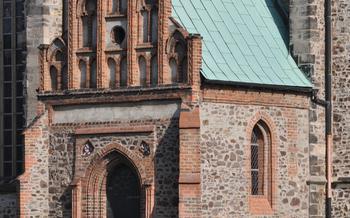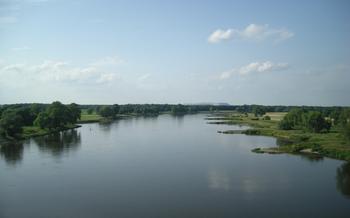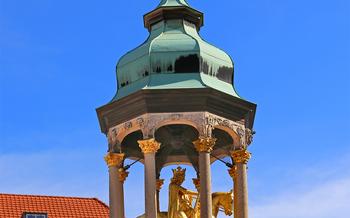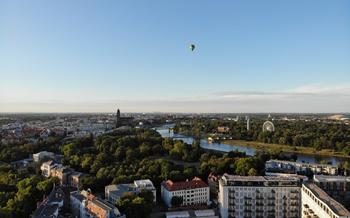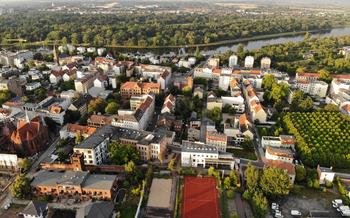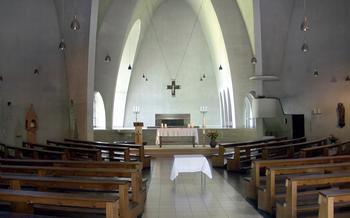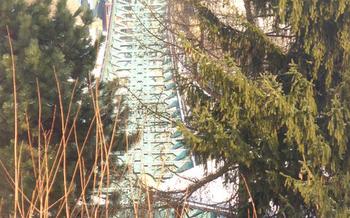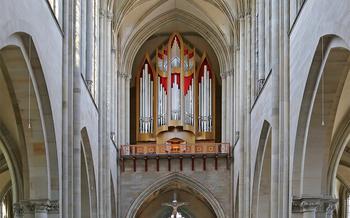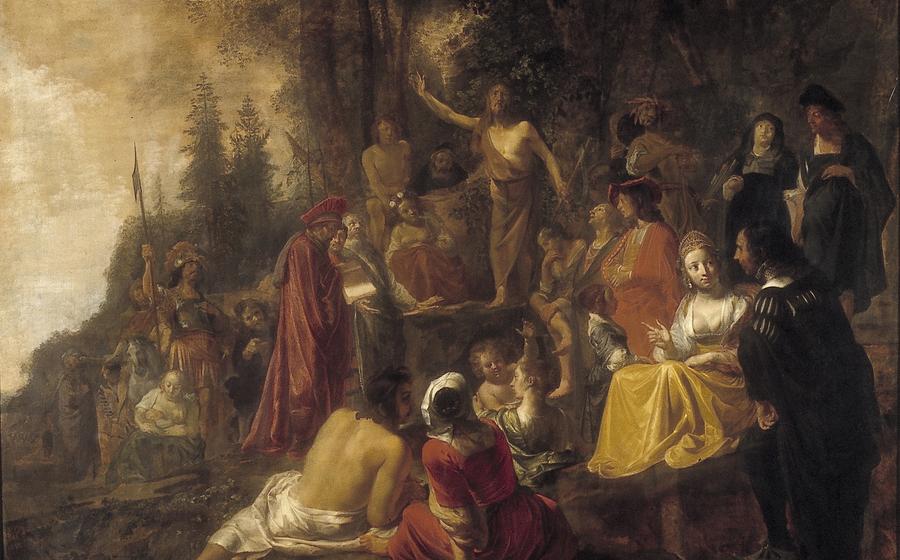
Magdeburg Cultural History Museum
- Magdeburg Cultural History Museum: A Journey Through Time
- Tracing Magdeburg's Roots: The Early Beginnings
- Magdeburg Cathedral: A Symbol of Resilience
- The Thirty Years' War and Magdeburg's Transformation
- Magdeburg's Industrial Revolution: A Turning Point
- World War II and Magdeburg's Reconstruction
- The Peaceful Revolution and German Reunification
- Magdeburg's Green Spaces: A Breath of Fresh Air
- Magdeburg Waterway Museum: Exploring the City's Waterways
- Magdeburg's Culinary Delights: A Taste of Tradition
- Magdeburg's Art Scene: Creativity and Expression
- Magdeburg for Families: Fun for All Ages
- Magdeburg's Nightlife: Vibrant and Diverse
- Insider Tip: Hidden Gem of Magdeburg
Magdeburg Cultural History Museum: A Journey Through Time
Step into the captivating world of Magdeburg's past at the Magdeburg Cultural History Museum, a treasure trove of artifacts and exhibits that narrate the city's rich and storied history. Immerse yourself in interactive displays and engage with hands-on experiences that bring the city's heritage to life. Discover the diverse collection that spans from prehistoric times to the present day, showcasing Magdeburg's rise from a humble settlement to a thriving metropolis.
The museum's exhibits are designed to appeal to visitors of all ages, offering educational and cultural experiences that ignite curiosity and spark imagination. Explore the archaeological findings that shed light on Magdeburg's earliest origins, marvel at the intricate craftsmanship of medieval artifacts, and learn about the city's pivotal role in major historical events. Whether you're a history buff, a culture enthusiast, or simply seeking a fascinating glimpse into Magdeburg's past, this museum promises an unforgettable journey through time.
Tracing Magdeburg's Roots: The Early Beginnings
Magdeburg's rich history dates back to the 9th century, and the Magdeburg Cultural History Museum offers a fascinating glimpse into the city's early beginnings. Archaeological findings and artifacts from this era, meticulously displayed in interactive exhibits, provide insights into the city's foundation and development during the Middle Ages. Visitors can explore interactive maps and timelines that visualize Magdeburg's growth from a small settlement to a prominent trading hub. Discover the stories of the city's early inhabitants, their customs, and the challenges they faced as Magdeburg evolved into a thriving center of commerce and culture.
Magdeburg Cathedral: A Symbol of Resilience
Majestically towering over the city skyline, Magdeburg Cathedral stands as a testament to the enduring spirit of Magdeburg. Constructed in the 13th century, this architectural marvel boasts a harmonious blend of Romanesque and Gothic styles, earning its place as one of the oldest and most significant cathedrals in Germany.
Step inside the cathedral's awe-inspiring interior, and prepare to be mesmerized by the intricate stained-glass windows that bathe the space in a kaleidoscope of colors. Admire the impressive sculptures that adorn the walls, each telling a story from the Bible or the history of Magdeburg.
Throughout the centuries, Magdeburg Cathedral has borne witness to countless events, both joyous and tragic. Its resilience has been tested by wars, fires, and natural disasters, yet it has always emerged stronger. During World War II, the cathedral suffered extensive damage from air raids, but it was painstakingly restored to its former glory after the war.
As you wander through the cathedral, take a moment to reflect on the stories of faith, hope, and resilience that these walls hold. Attend a service or concert to experience the cathedral's vibrant acoustics and feel the spiritual energy that permeates the air.
Magdeburg Cathedral is not just a historical landmark; it is a living symbol of the city's unwavering spirit. Its doors are always open, welcoming visitors from all walks of life to come and marvel at its beauty, learn its history, and find solace within its sacred walls.
The Thirty Years' War and Magdeburg's Transformation
The Thirty Years' War, a devastating conflict that ravaged Europe from 1618 to 1648, left an indelible mark on Magdeburg. In 1631, the city fell victim to one of the most brutal sackings in the war's history. Imperial troops under the command of Albrecht von Wallenstein stormed the city, resulting in widespread destruction, looting, and the deaths of thousands of civilians.
The Magdeburg Cultural History Museum vividly portrays the city's suffering and resilience during this tumultuous period. Interactive exhibits, such as virtual reality simulations and touchscreens, allow visitors to experience the siege firsthand. Historical artifacts, including weapons, armor, and personal belongings, provide a tangible connection to the past.
One of the most poignant displays focuses on the aftermath of the sacking. Visitors can view heart-wrenching images of the ruined city, read accounts from survivors, and learn about the long and arduous process of rebuilding. The museum also highlights stories of individual courage and determination, such as the heroic efforts of Mayor Otto Guericke, who tirelessly worked to restore Magdeburg to its former glory.
Through these exhibits, the Magdeburg Cultural History Museum not only sheds light on a dark chapter in the city's history but also celebrates the indomitable spirit of its people. It serves as a reminder of the devastating consequences of war and the importance of peace and reconciliation.
Magdeburg's Industrial Revolution: A Turning Point
The 19th century marked a turning point in Magdeburg's history as the city embraced the Industrial Revolution. Heavy industry and manufacturing flourished, transforming Magdeburg into a major industrial hub. Interactive displays at the Magdeburg Cultural History Museum showcase the technological innovations and inventions that drove this transformation. Visitors can explore the impact of industrialization on the city's landscape, economy, and society.
The museum brings to life the stories of entrepreneurs, engineers, and workers who played a pivotal role in Magdeburg's industrial development. Visitors can learn about the challenges and opportunities that shaped the city's industrial heritage. From the rise of steam engines to the development of electrical machinery, the exhibits provide insights into the technological advancements that revolutionized Magdeburg's industries.
Interactive displays allow visitors to experience the working conditions and social changes that accompanied industrialization. They can explore replicas of factories, operate machinery, and learn about the impact of industrialization on the lives of ordinary people. The museum also highlights the social and environmental challenges that emerged during this period, such as worker's rights, pollution, and urban poverty.
World War II and Magdeburg's Reconstruction
The scars of World War II are still visible in Magdeburg, a city that endured extensive damage from air raids and bombings. The city center, once a vibrant hub of activity, was reduced to rubble, and many of its historic buildings were destroyed. The Magdeburg Cultural History Museum tells the story of this dark chapter in the city's history and its remarkable reconstruction efforts.
Through interactive exhibits, visitors can learn about the devastating impact of the war on Magdeburg and its people. Personal accounts and stories of survival bring the past to life, offering a glimpse into the resilience and determination of the city's inhabitants.
The exhibits showcase the post-war efforts to rebuild Magdeburg and restore its cultural heritage. Photographs, documents, and artifacts illustrate the challenges faced by the city's residents as they worked to clear the rubble, rebuild homes and businesses, and revive the city's economy.
Magdeburg's reconstruction was a symbol of hope and renewal. The city rose from the ashes of war, and its people worked tirelessly to create a new future for themselves and their children. The Magdeburg Cultural History Museum stands as a testament to this remarkable journey, reminding visitors of the power of resilience and the indomitable spirit of the human will.
The Peaceful Revolution and German Reunification
Magdeburg played a pivotal role in the non-violent protests that led to the fall of the Berlin Wall and the reunification of Germany. The city was a hotbed of resistance against the communist regime, with citizens organizing demonstrations, forming underground networks, and distributing opposition literature. The Magdeburg Cultural History Museum offers a comprehensive exhibit on this transformative period, showcasing the events and key figures of the movement.
Interactive displays immerse visitors in the atmosphere of the peaceful revolution, allowing them to experience the courage and determination of the people who stood up for their rights. Personal accounts and stories from participants in the protests bring the history to life, providing a deeper understanding of the challenges and triumphs of this pivotal era.
Visitors can learn about the role of Magdeburg's churches in providing sanctuary and support to dissidents, as well as the city's role in the Round Table talks that paved the way for German reunification. The museum also highlights the contributions of Magdeburg citizens to the peaceful revolution, showcasing their unwavering commitment to freedom and democracy.
Magdeburg's Green Spaces: A Breath of Fresh Air
Amidst the urban expanse of Magdeburg lies a network of tranquil green spaces, inviting visitors to escape the city's hustle and bustle. These parks, gardens, and natural reserves offer a refreshing respite, providing opportunities for relaxation, recreation, and exploration.
The interactive maps and guides available at the tourist information centers or online help you plan your green adventure. Discover the serene beauty of the Stadtpark Rotehorn, with its sprawling lawns, colorful flowerbeds, and a charming Japanese garden. For a touch of history, stroll through the Herrenkrug Park, home to the remains of a medieval castle and a picturesque lake.
Families can enjoy a day of fun and learning at the Elbauenpark, Germany's largest inner-city park. With over 100 hectares of diverse attractions, including a cable car, a Japanese garden, and a rose garden, there's something for everyone in this urban oasis.
Whether you seek a peaceful retreat, an active adventure, or a family-friendly outing, Magdeburg's green spaces offer a sanctuary for rejuvenation and connection with nature. Embrace the tranquility of these urban havens and let the fresh air invigorate your senses.
Magdeburg Waterway Museum: Exploring the City's Waterways
Magdeburg's rich history is deeply intertwined with its waterways, particularly the Elbe River. The Magdeburg Waterway Museum, located on the banks of the Elbe, offers a fascinating journey into the city's maritime heritage. Through interactive exhibits and displays, visitors can explore the development of shipping and trade along the river, as well as the engineering marvel that is the Magdeburg Waterway Bridge.
The museum houses a collection of model ships, navigation instruments, and historical documents that provide insights into the lives of sailors, merchants, and shipbuilders of the past. Visitors can learn about the challenges and triumphs of navigating the Elbe's treacherous waters and the vital role that waterways played in Magdeburg's economic growth.
One of the highlights of the museum is the interactive display on the Magdeburg Waterway Bridge. This engineering masterpiece, completed in 2003, is the longest navigable aqueduct in the world. Visitors can explore a scale model of the bridge, learn about its construction, and even experience a virtual boat trip across its impressive structure.
The museum also offers boat tours and cruises from its harbor, providing visitors with a unique perspective of Magdeburg's waterways. These tours offer stunning views of the city skyline, the surrounding countryside, and the Elbe's diverse wildlife.
Whether you're a history buff, an engineering enthusiast, or simply someone who enjoys spending time by the water, the Magdeburg Waterway Museum is a must-visit attraction. It offers a captivating glimpse into the city's maritime heritage and the vital role that waterways have played in shaping Magdeburg's identity.
Magdeburg's Culinary Delights: A Taste of Tradition
Magdeburg's culinary scene is a vibrant tapestry of flavors, influenced by regional and seasonal ingredients. The city's rich history and cultural diversity have contributed to a unique gastronomic experience that is sure to tantalize your taste buds.
One of the must-try specialties is the Magdeburger Baumkuchen (tree cake), a traditional German cake that resembles a tree trunk with its distinctive rings. This delicious cake is made with layers of batter that are baked on a spit over an open fire, creating a unique texture and flavor.
Another local delicacy is Punschel, a hot punch that is especially popular during the cold winter months. Made with a blend of spices, citrus fruits, and red wine, this warming beverage is sure to chase away the winter chill.
For an authentic culinary experience, be sure to visit one of Magdeburg's many local restaurants and markets. The Zentralmarkt (Central Market) is a great place to find fresh produce, regional specialties, and traditional dishes. Here, you can sample local cheeses, sausages, and freshly baked bread, or indulge in a hearty bowl of Magdeburger Kartoffelsuppe (potato soup).
Whether you're looking for a traditional German meal or a more modern culinary experience, Magdeburg has something to offer every foodie. So, come hungry and prepare to embark on a culinary adventure that will leave your taste buds dancing with delight.
Magdeburg's Art Scene: Creativity and Expression
Magdeburg's vibrant art scene is a testament to the city's rich cultural heritage and its embrace of contemporary artistic expression. Scattered throughout the city, art galleries, studios, and exhibition spaces offer a diverse range of artistic experiences for visitors and locals alike.
At the Kunstmuseum Magdeburg, explore an impressive collection of modern and contemporary art, featuring works by renowned German and international artists. The museum's rotating exhibitions showcase a variety of mediums, from paintings and sculptures to photography and installations.
For a glimpse into the city's emerging art scene, visit the Kunsthalle Magdeburg. This non-profit gallery provides a platform for local and regional artists to showcase their work, often hosting experimental and thought-provoking exhibitions.
Take a stroll through the Kreatives Viertel (Creative Quarter), a vibrant neighborhood known for its concentration of art galleries, studios, and design shops. Here, you can browse unique handmade crafts, admire street art murals, and engage with local artists in their creative spaces.
To immerse yourself in the city's artistic community, join one of the many art walks or workshops offered throughout the year. These events provide an opportunity to meet local artists, learn about their techniques, and even try your hand at creating your own artwork.
Whether you're an art enthusiast or simply looking for a creative experience, Magdeburg's art scene offers something for everyone. Embrace the city's artistic spirit and discover the hidden gems that await you around every corner.
Magdeburg for Families: Fun for All Ages
Magdeburg offers a wealth of attractions and experiences tailored to families with children of all ages. The Zoo Magdeburg, located in the heart of the city, is a must-visit for animal lovers. With over 1,500 animals from all over the world, including lions, elephants, and giraffes, the zoo provides a fun and educational day out for the whole family.
The Technikmuseum Magdeburg, housed in a former railway depot, is another popular destination for families. With over 20,000 exhibits showcasing the history of technology, science, and industry, the museum offers hands-on experiences and interactive displays that will fascinate children and adults alike.
For outdoor adventures, Magdeburg offers several family-friendly parks and gardens. The Stadtpark Rotehorn, with its large playground, duck pond, and miniature railway, is a favorite among families. The Elbauenpark, Germany's largest inner-city park, boasts a cable car, a Japanese garden, and a rose garden, providing a scenic backdrop for picnics and leisurely walks.
Magdeburg's museums also cater to younger visitors. The Kulturhistorisches Museum Magdeburg offers interactive exhibits and workshops designed to engage children with the city's history and culture. The Puppentheater Magdeburg, with its enchanting puppet shows, is a delight for children of all ages.
When it comes to dining, Magdeburg offers a range of family-friendly restaurants. Many restaurants have dedicated children's menus and offer high chairs and changing facilities for convenience. Local specialties like Magdeburger Baumkuchen (tree cake) and Punschel (hot punch) are sure to be a hit with both children and adults.
Magdeburg's Nightlife: Vibrant and Diverse
Magdeburg's nightlife scene offers a vibrant mix of bars, clubs, and music venues catering to diverse tastes. Whether you're into live music, DJs, or themed events, there's something for everyone in this lively city.
For a taste of Magdeburg's music scene, head to Moritzhof, a cultural center that hosts concerts by local and international artists. Alternatively, check out Factory, a former industrial complex transformed into a creative hub with multiple music venues and art galleries.
If you're looking for a more relaxed atmosphere, there are plenty of cozy bars and pubs to choose from. For a traditional German experience, try the Ratskeller, located in the heart of the city's Old Town. Or, for a taste of international flavors, head to one of the many bars in the vibrant Buckau district.
Magdeburg also hosts several themed events and festivals throughout the year. One of the most popular is the jährliche Weinfest (annual wine festival), which takes place in the summer and features wine tasting, live music, and food stalls. Another highlight is the Magdeburger Kulturnacht (Magdeburg Cultural Night), when museums, galleries, and theaters stay open late and offer special events and exhibitions.
To experience Magdeburg's nightlife like a local, venture off the beaten path and explore the city's hidden gems. Ask locals for recommendations or do some research online to find underground bars, secret parties, and alternative music venues.
Remember to drink responsibly and stay safe when exploring Magdeburg's nightlife. Taxis and public transportation are readily available to ensure you get home safely after a night out.
Insider Tip: Hidden Gem of Magdeburg
Beyond the well-known attractions, Magdeburg boasts a treasure trove of hidden gems waiting to be discovered. For a glimpse into the city's rich history, visit the Kulturhistorisches Museum Ottersleben, housed in a former monastery. This museum showcases the fascinating story of Ottersleben, a district that predates Magdeburg itself.
Explore the Buckau district, once a thriving industrial hub, now transformed into a vibrant cultural quarter. Admire the stunning street art adorning the buildings and uncover the district's unique history through guided tours.
For a unique perspective of the city, take a leisurely stroll along the Stadtpark Rotehorn, a beautiful park located on the banks of the Elbe River. Enjoy panoramic views of the city skyline, relax by the tranquil lake, or visit the impressive Japanese Garden, a hidden oasis within the park.
Indulge in a culinary adventure at one of Magdeburg's many hidden culinary gems. Try the traditional Magdeburger Schnitzel, a crispy pork cutlet served with potato salad and seasonal vegetables. For a sweet treat, visit the Café Krömer, a charming café known for its mouthwatering Baumkuchen, a traditional German cake.
Discover the hidden treasures of Magdeburg by venturing off the beaten path. These lesser-known attractions offer a unique glimpse into the city's rich history, vibrant culture, and culinary delights, leaving you with unforgettable memories of your visit.
